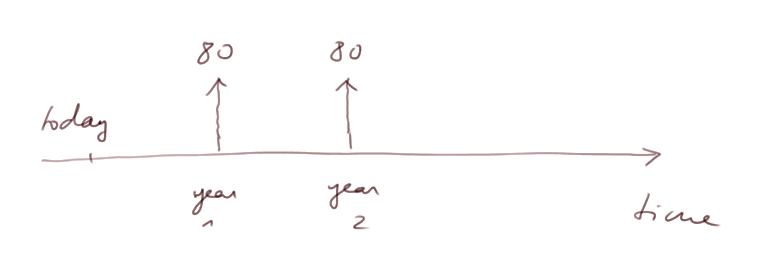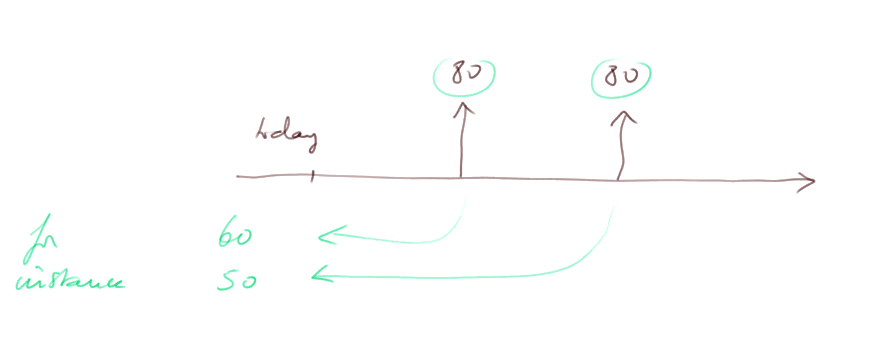Elementary finance
Physical and financial investments
Text
introduction
projected investment
financial investment: the cash flows of A and I simply add up
physical investment: the new cash flows are not just the sum
difference between the two types of investment
example of financial investment
NPV of a financial investment
example of physical investment: the startling case of eBay's purchase of Skype
what eBay was actually buying in buying Skype
Google and Groupon
The intuitive distinction between physical and financial investments is clear:
- a physical investment consists in buying a machine tool, a loom, a truck, or a plant, etc., to put it to work
- a financial investment consists in buying a piece of paper promising some future payments.
This distinction is essentially correct. But we shall give it a more formal expression, using cash flows, which will make it clearer, and more operational.
Let's look at an agent A (the investor) who is considering making an investment I.
And to start with, let us look at A and I separately. That is we look at the future cash flows of A and of I if they "do not marry".
Suppose A alone would have the following future cash flows

and I alone would have

Financial investment. If, after having bought I, the new projected cash flows of A are simply the sums of the CF alone

then, by definition, purchasing I is a financial investment.
Physical investment. Whereas if, after having bought I, the new cash flows of A are different from the sum of the cash flows alone

(for example, here most CF are more than the sum of the corresponding CFs alone)
then, by definition, purchasing I is a physical investment.
- an investment which does not interfere with our other activities is a financial investment. Its cash flows (CFs) are just added on top of our other ones.
- whereas a physical investment affects our other activities
You could say that in a physical investment 2 + 2 does not make 4. In favorable cases, it makes more.
Example of a financial investment:
Agent A (for instance, ourselves) buys from B a promise to receive the following future cash flows

(I've not specified yet, the price paid by A to B today)
Unless buying this promise affects our other activities, this is a financial investment.
The two future CF have a present value (depending on various factors we shall study)

So, in this example, as in any financial investment, we simply buy some future cash flows, with no monetary impact, present or future, on our other activities. These promised cash flows have a value today. It is the same for the buyer and for the seller.
If the seller is reasonable, it is the price we shall have to pay today.
Therefore in any financial investment NPV = 0.
Let's be clear about NPV's: to say that the NPV = 0 doesn't mean that the sum of the face values of the future cash flows (here 80 and 80) is equal to the price we have to pay today. If we add up the future values and subtract the price today, we get 50. But this is a calculation that is considered meaningless in finance. It adds up apples and oranges.
What is meaningful is to compare various values at the same date, usually today.
There is much more to say about the present value of future cash flows, even in financial investments. For example, buying appartments for rent is a financial investment. All this will be developed in coming lessons. Let's now turn to physical investments, with a startling example.
In a physical investment, the story is quite different. We illustrate it with a striking example.
In the Fall of 2005, eBay purchased Skype:
- Skype was only 3 years old, had a turnover of the order of magnitude of $10 million, and had made only losses
- its future cash flows as a standalone firm were small
Yet, eBay paid $2.6 billion for the acquisition of 100% of Skype!
How did eBay reason?
Answer: eBay compared its own future CFs without Skype and with Skype. I don't have the internal documents of eBay at the time, of course, but we can reconstitute a plausible analysis, made at the time by its management.
Suppose eBay estimated that the first year after the acquisition of Skype its cash flow would be $500 million higher than without Skype; the second year the extra cash flow would be $1000 million; and then for the next eight years the extra cash flow, "created" by Skype acquisition, would be $2000 million each year.
Then, eBay computed, with its own recipes, that the present values of all these future extra cash flows would be this

It found that the sum of these present values was $3246 million.
In other words, the value of Skype for eBay was $3.2 billion.
Furthermore, as we said, Skype as a "standalone" was not worth very much. Its future cash flows, with no operations with a big firm, were projected to be small. (Of course such reasoning is full of paradoxes, because, to begin with, Skype wouldn't have staid alone. It interested other potential acquirers. But, at any rate, for eBay it was worth $3.2 billion.)
Skype founders/owners, however, were aware of that. They had crunched numbers, as above, from the point of view of eBay.
So the purchase negotiations began with a price range between $0 and $3.2 billion.
Skype negotiators were skillful enough to settle on $2.6 billion.
At this purchasing price, Skype acquisition for eBay still had a positive NPV of $600 million. It was value created "instantly". We shall come back many times to this concept at first difficult to grasp.
One last note. Even though the previous analysis explains why such a price was reasonable, it still appears mind boggling. In fact, one can say that you didn't need $3.2 billion to construct by yourself Skype technology. Correct! But eBay would have needed several years, no matter how much money it poured into the in-house project. Then it is easy to show that Skype's acquisition was preferable. In other words, by purchasing Skype, eBay didn't buy technology but time.
In the Fall of 2010, Google showed interest in the acquisition of Groupon. The story bears some resemblance with eBay and Skype. Groupon is also quite recent. It would also be a physical investment for Google, who expected new cash flows to be much higher than just the sum of Google and Groupon cash flows separately. Google made a first offer at $3 billion (a sum already almost twice as high as what Google paid for YouTube in 2006), which was turned down. Then it made a second one at $6 billion, which was turned down too. As of February 2011, no deal was struck, and it looks as though Groupon has chosen to develop alone.
Screens of the video
|
|
|
screen number display zone |
Course table of contents
Contact